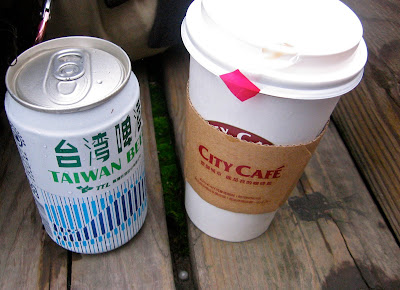This short hike (more like hellishly steep, but short, stair climb in nature) is quite well known, covered in Taipei Escapes, Taipei Day Trips, and blogged by David on Formosa. I hadn't done it before, though, so I thought I'd add a few photos. It begins in Xindian (or Maokong if you are so inclined), snakes up (or down) a stair-trail through the mountains and takes in a slender silver waterfall backed by a cave, into which a retro little temple has been built.
It will also get its own entry under "easy day hikes in Taipei for lazy people" (updated!) as you can easily begin this hike around or even after lunch time and arrive in Maokong with a comfortable amount of daylight remaining. Its fairly unchallenging nature - unless you hate stairs (and I do) - proximity and short duration are perfect for those who want to do something but didn't get up until 10am.
I like this hike because it connects two disparate parts of the greater Taipei area: Maokong/Muzha and Xindian. You go up the long, ridge-like Maokong mountain, stop at a waterfall and temple on the way, pass a short trail to the summit (you can head up there if you like - but there's no view) and then come down to the road across the street from Maokong's cable car station. Straight up and straight down.
There are buses and such you can take to get there; you can take any bus headed along Beiyi Road (Highway 9 or 北宜公路) towards Pinglin and get off at Yinhe Road (銀河路), hiking up from there. However, it's only about NT155 to take a taxi from MRT Xindian to the trail entrance (tell any driver you want to go to 銀河洞越嶺步道 on Yinhe Road), so why not just do that?
Or you can go the other way - take the gondola to the top of Maokong, and directly across the street start hiking up the hill past the temple under renovation, turning behind a house (should be marked), past an old stone house, and up some more on a concrete path until you hit the woods again. Past the summit and then down, down, down to the waterfall and Xindian, and catch a bus on Beiyi Road back to the MRT. This way involves less uphill hiking and few, if any, uphill stairs.
But we went the hard way, and ended up in Maokong at a great time for tea and snacks, hanging out until sunset and dinnertime. We went to my favorite teahouse on Maokong, 山中茶 - I like their fried sweet potato and their lemon diced chicken (檸檬雞丁).
This trail is very much discovered - solo hikers (it's very safe) and large groups, often with dogs, meander along it, stopping for lunch near the temple. The temple itself was built sometime after the KMT landed in Taiwan, and tiles painted with a story in Chinese marking this fact, plus the obvious non-fact that "everyone in Taiwan celebrated Retrocession Day" (uh, NO THEY DIDN'T) and a list of temple donors.
You can walk behind the waterfall up a path just beyond the cave - the path continues, but it's better to take the path up to the right of the temple for a quicker ascent to Maokong.



































